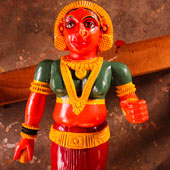Design Resource
Wooden Bhoota Figures - Udupi, Karnataka
Art of Traditional Udupi Wooden Statue Making
by
Prof. Bibhudutta Baral,Divyadarshan C S and Lija M G
It starts from a pooja and distribution of prasadam among devotees of the tree which is considered for carving Bhoota figures. Generally, customers help the craftsmen to locate Hebbelsu and Halasu trees in their region which are sacred for these kinds of idols. Gudigar community get regular orders to carve Bhoota figures and are replaced with old ones as they fade due to various factors like age of wood, deterioration of surface treatment (wood paint).
Seasoned wood log is used and sawed to obtain a block of the required size, on which rough sketching is done with a pencil looking at other idols and based on the experience of a craftsman. Unwanted wood is removed layer by layer in large quantities (rough carving) and the same process of removing the wood is continued in small quantities (semi-finish carving) and continued using scraping tools. Detailing of body parts like eyes, nose and ears are done with carving tools to obtain a well-crafted idol. Hands are made separately and joined using a keel (structure member) with wood-adhesive to wedge (fix in place) the hands to the body.
The outer surface of the body is treated with enamel paint as a basic coat. Further, a coat of wood varnish is applied to get smooth finish. Other parts like the eyes, and nose are painted with various sizes of brushes to increase the look of the idol. The earlier chemical powder was preferred for coloring the statue that used to flow away when it comes in contact with water. For the past thirty years, enamel paints are preferred for coloring onto the statue. After the painting is completed, an artificial sword and Trishula are fixed to the statue.
It takes about two and a half to three months to complete small idols, whereas 3 to 4 months is required for bigger sized idols of around 6 to 7 feet as per the intricacy of the design. Ornaments are decided and carved based on the style (shyali) of the idol.
Finally, finished statues are delivered by performing pooja (referred to as Kala Koduvudu or Bettu Koduvudu which means asking forgiveness to the tree for hurting it to make it into a carved form) to temples, where priests perform rituals on a daily basis as it turned to the idol for worshipping.

























